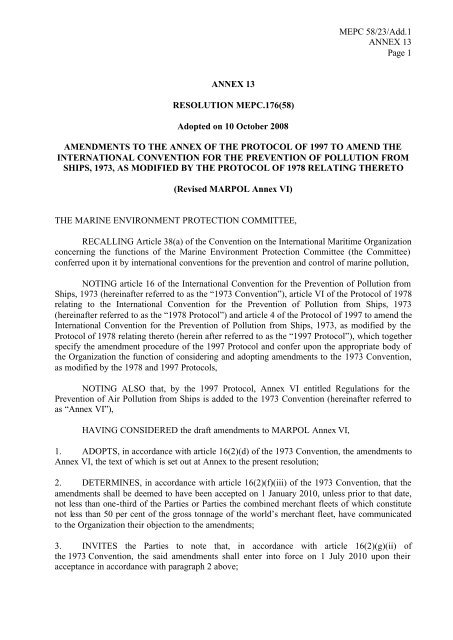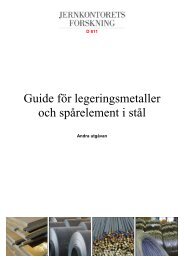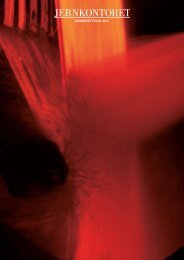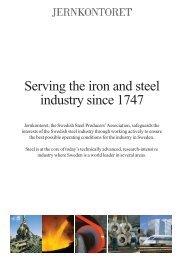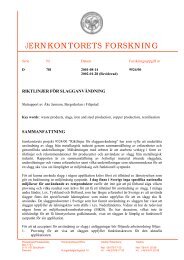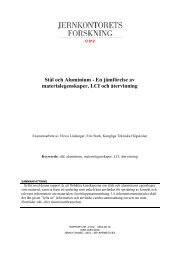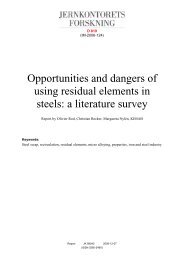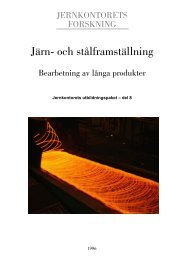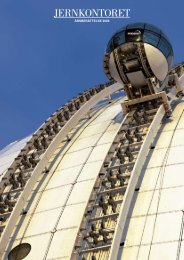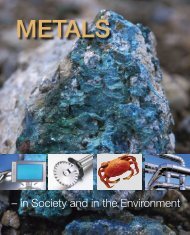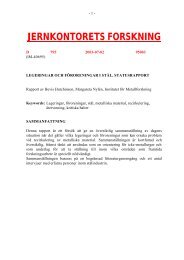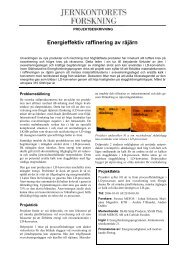MEPC.176(58) - International Maritime Organization
MEPC.176(58) - International Maritime Organization
MEPC.176(58) - International Maritime Organization
Create successful ePaper yourself
Turn your PDF publications into a flip-book with our unique Google optimized e-Paper software.
MEPC <strong>58</strong>/23/Add.1ANNEX 13Page 1ANNEX 13RESOLUTION <strong>MEPC.176</strong>(<strong>58</strong>)Adopted on 10 October 2008AMENDMENTS TO THE ANNEX OF THE PROTOCOL OF 1997 TO AMEND THEINTERNATIONAL CONVENTION FOR THE PREVENTION OF POLLUTION FROMSHIPS, 1973, AS MODIFIED BY THE PROTOCOL OF 1978 RELATING THERETO(Revised MARPOL Annex VI)THE MARINE ENVIRONMENT PROTECTION COMMITTEE,RECALLING Article 38(a) of the Convention on the <strong>International</strong> <strong>Maritime</strong> <strong>Organization</strong>concerning the functions of the Marine Environment Protection Committee (the Committee)conferred upon it by international conventions for the prevention and control of marine pollution,NOTING article 16 of the <strong>International</strong> Convention for the Prevention of Pollution fromShips, 1973 (hereinafter referred to as the “1973 Convention”), article VI of the Protocol of 1978relating to the <strong>International</strong> Convention for the Prevention of Pollution from Ships, 1973(hereinafter referred to as the “1978 Protocol”) and article 4 of the Protocol of 1997 to amend the<strong>International</strong> Convention for the Prevention of Pollution from Ships, 1973, as modified by theProtocol of 1978 relating thereto (herein after referred to as the “1997 Protocol”), which togetherspecify the amendment procedure of the 1997 Protocol and confer upon the appropriate body ofthe <strong>Organization</strong> the function of considering and adopting amendments to the 1973 Convention,as modified by the 1978 and 1997 Protocols,NOTING ALSO that, by the 1997 Protocol, Annex VI entitled Regulations for thePrevention of Air Pollution from Ships is added to the 1973 Convention (hereinafter referred toas “Annex VI”),HAVING CONSIDERED the draft amendments to MARPOL Annex VI,1. ADOPTS, in accordance with article 16(2)(d) of the 1973 Convention, the amendments toAnnex VI, the text of which is set out at Annex to the present resolution;2. DETERMINES, in accordance with article 16(2)(f)(iii) of the 1973 Convention, that theamendments shall be deemed to have been accepted on 1 January 2010, unless prior to that date,not less than one-third of the Parties or Parties the combined merchant fleets of which constitutenot less than 50 per cent of the gross tonnage of the world’s merchant fleet, have communicatedto the <strong>Organization</strong> their objection to the amendments;3. INVITES the Parties to note that, in accordance with article 16(2)(g)(ii) ofthe 1973 Convention, the said amendments shall enter into force on 1 July 2010 upon theiracceptance in accordance with paragraph 2 above;
MEPC <strong>58</strong>/23/Add.1ANNEX 13Page 24. REQUESTS the Secretary-General, in conformity with article 16(2)(e) ofthe 1973 Convention, to transmit to all Parties to the 1973 Convention, as modified by the 1978and 1997 Protocols, certified copies of the present resolution and the text of the amendmentscontained in the Annex;5. REQUESTS FURTHER the Secretary-General to transmit to the Members of the<strong>Organization</strong> which are not Parties to the 1973 Convention, as modified by the 1978and 1997 Protocols, copies of the present resolution and its Annex; and6. INVITES the Parties to MARPOL Annex VI and other Member Governments to bringthe amendments to MARPOL Annex VI to the attention of shipowners, ship operators,shipbuilders, marine diesel engine manufacturers, marine fuel suppliers and any otherinterested groups.
MEPC <strong>58</strong>/23/Add.1ANNEX 13Page 3ANNEXREVISED MARPOL ANNEX VIRegulations for the Prevention of Air Pollution from ShipsCHAPTER IGENERALRegulation 1ApplicationThe provisions of this Annex shall apply to all ships, except where expressly provided otherwisein regulations 3, 5, 6, 13, 15, 16 and 18 of this Annex.Regulation 2DefinitionsFor the purpose of this Annex:1 Annex means Annex VI to the <strong>International</strong> Convention for the Prevention of Pollutionfrom Ships 1973 (MARPOL), as modified by the Protocol of 1978 relating thereto, and asmodified by the Protocol of 1997, as amended by the <strong>Organization</strong>, provided that suchamendments are adopted and brought into force in accordance with the provisions of article 16 ofthe present Convention.2 A similar stage of construction means the stage at which:.1 construction identifiable with a specific ship begins; and.2 assembly of that ship has commenced comprising at least 50 tons or one per centof the estimated mass of all structural material, whichever is less.3 Anniversary date means the day and the month of each year which will correspond to thedate of expiry of the <strong>International</strong> Air Pollution Prevention Certificate.4 Auxiliary control device means a system, function, or control strategy installed on amarine diesel engine that is used to protect the engine and/or its ancillary equipment againstoperating conditions that could result in damage or failure, or that is used to facilitate the startingof the engine. An auxiliary control device may also be a strategy or measure that has beensatisfactorily demonstrated not to be a defeat device.5 Continuous feeding is defined as the process whereby waste is fed into a combustionchamber without human assistance while the incinerator is in normal operating conditions withthe combustion chamber operative temperature between 850°C and 1,200°C.
MEPC <strong>58</strong>/23/Add.1ANNEX 13Page 46 Defeat device means a device which measures, senses, or responds to operating variables(e.g., engine speed, temperature, intake pressure or any other parameter) for the purpose ofactivating, modulating, delaying or deactivating the operation of any component or the functionof the emission control system such that the effectiveness of the emission control system isreduced under conditions encountered during normal operation, unless the use of such a device issubstantially included in the applied emission certification test procedures.7 Emission means any release of substances, subject to control by this Annex, from shipsinto the atmosphere or sea.8 Emission Control Area means an area where the adoption of special mandatory measuresfor emissions from ships is required to prevent, reduce and control air pollution from NO x or SO xand particulate matter or all three types of emissions and their attendant adverse impacts onhuman health and the environment. Emission Control Areas shall include those listed in, ordesignated under, regulations 13 and 14 of this Annex.9 Fuel oil means any fuel delivered to and intended for combustion purposes for propulsionor operation on board a ship, including distillate and residual fuels.10 Gross tonnage means the gross tonnage calculated in accordance with the tonnagemeasurement regulations contained in Annex I to the <strong>International</strong> Convention on TonnageMeasurements of Ships, 1969 or any successor Convention.11 Installations in relation to regulation 12 of this Annex means the installation of systems,equipment including portable fire-extinguishing units, insulation, or other material on a ship, butexcludes the repair or recharge of previously installed systems, equipment, insulation, or othermaterial, or the recharge of portable fire-extinguishing units.12 Installed means a marine diesel engine that is or is intended to be fitted on a ship,including a portable auxiliary marine diesel engine, only if its fuelling, cooling, or exhaustsystem is an integral part of the ship. A fuelling system is considered integral to the ship only ifit is permanently affixed to the ship. This definition includes a marine diesel engine that is usedto supplement or augment the installed power capacity of the ship and is intended to be anintegral part of the ship.13 Irrational emission control strategy means any strategy or measure that, when the ship isoperated under normal conditions of use, reduces the effectiveness of an emission control systemto a level below that expected on the applicable emission test procedures.14 Marine diesel engine means any reciprocating internal combustion engine operating onliquid or dual fuel, to which regulation 13 of this Annex applies, including booster/compoundsystems if applied.15 NO x Technical Code means the Technical Code on Control of Emission of NitrogenOxides from Marine Diesel Engines adopted by resolution 2 of the 1997 MARPOL Conference,as amended by the <strong>Organization</strong>, provided that such amendments are adopted and brought intoforce in accordance with the provisions of article 16 of the present Convention.
MEPC <strong>58</strong>/23/Add.1ANNEX 13Page 516 Ozone depleting substances means controlled substances defined in paragraph (4) ofarticle 1 of the Montreal Protocol on Substances that Deplete the Ozone Layer, 1987, listed inAnnexes A, B, C or E to the said Protocol in force at the time of application or interpretation ofthis Annex.Ozone depleting substances that may be found on board ship include, but are notlimited to:Halon 1211 BromochlorodifluoromethaneHalon 1301 BromotrifluoromethaneHalon 2402 1, 2-Dibromo -1, 1, 2, 2-tetraflouroethane (also known as Halon 114B2)CFC-11 TrichlorofluoromethaneCFC-12 DichlorodifluoromethaneCFC-113 1, 1, 2 – Trichloro – 1, 2, 2 – trifluoroethaneCFC-114 1, 2 – Dichloro –1, 1, 2, 2 – tetrafluoroethaneCFC-115 Chloropentafluoroethane17 Shipboard incineration means the incineration of wastes or other matter on board a ship,if such wastes or other matter were generated during the normal operation of that ship.18 Shipboard incinerator means a shipboard facility designed for the primary purpose ofincineration.19 Ships constructed means ships the keels of which are laid or which are at a similar stageof construction.20 Sludge oil means sludge from the fuel oil or lubricating oil separators, waste lubricatingoil from main or auxiliary machinery, or waste oil from bilge water separators, oil filteringequipment or drip trays.21 Tanker means an oil tanker as defined in regulation 1 of Annex I or a chemical tanker asdefined in regulation 1 of Annex II of the present Convention.Regulation 3Exceptions and ExemptionsGeneral1 Regulations of this Annex shall not apply to:.1 any emission necessary for the purpose of securing the safety of a ship or savinglife at sea; or
.2 any emission resulting from damage to a ship or its equipment:MEPC <strong>58</strong>/23/Add.1ANNEX 13Page 6.2.1 provided that all reasonable precautions have been taken after theoccurrence of the damage or discovery of the emission for the purpose ofpreventing or minimizing the emission; and.2.2 except if the owner or the master acted either with intent to cause damage,or recklessly and with knowledge that damage would probably result.Trials for Ship Emission Reduction and Control Technology Research2 The Administration of a Party may, in co-operation with other Administrations asappropriate, issue an exemption from specific provisions of this Annex for a ship to conduct trialsfor the development of ship emission reduction and control technologies and engine designprogrammes. Such an exemption shall only be provided if the applications of specific provisionsof the Annex or the revised NO x Technical Code 2008 could impede research into thedevelopment of such technologies or programmes. A permit for such an exemption shall only beprovided to the minimum number of ships necessary and be subject to the following provisions:.1 for marine diesel engines with a per cylinder displacement up to 30 litres, theduration of the sea trial shall not exceed 18 months. If additional time is required,a permitting Administration or Administrations may permit a renewal for oneadditional 18-month period; or.2 for marine diesel engines with a per cylinder displacement at or above 30 litres,the duration of the ship trial shall not exceed 5 years and shall require a progressreview by the permitting Administration or Administrations at each intermediatesurvey. A permit may be withdrawn based on this review if the testing has notadhered to the conditions of the permit or if it is determined that the technology orprogramme is not likely to produce effective results in the reduction and control ofship emissions. If the reviewing Administration or Administrations determine thatadditional time is required to conduct a test of a particular technology orprogramme, a permit may be renewed for an additional time period not to exceedfive years.Emissions from Sea-bed Mineral Activities3.1 Emissions directly arising from the exploration, exploitation and associated offshoreprocessing of sea-bed mineral resources are, consistent with article 2(3)(b)(ii) of the presentConvention, exempt from the provisions of this Annex. Such emissions include the following:.1 emissions resulting from the incineration of substances that are solely and directlythe result of exploration, exploitation and associated offshore processing ofsea-bed mineral resources, including but not limited to the flaring of hydrocarbonsand the burning of cuttings, muds, and/or stimulation fluids during wellcompletion and testing operations, and flaring arising from upset conditions;.2 the release of gases and volatile compounds entrained in drilling fluids andcuttings;
MEPC <strong>58</strong>/23/Add.1ANNEX 13Page 7.3 emissions associated solely and directly with the treatment, handling, or storage ofsea-bed minerals; and.4 emissions from marine diesel engines that are solely dedicated to the exploration,exploitation and associated offshore processing of sea-bed mineral resources.3.2 The requirements of regulation 18 of this Annex shall not apply to the use ofhydrocarbons which are produced and subsequently used on site as fuel, when approved by theAdministration.Regulation 4Equivalents1 The Administration of a Party may allow any fitting, material, appliance or apparatus tobe fitted in a ship or other procedures, alternative fuel oils, or compliance methods used as analternative to that required by this Annex if such fitting, material, appliance or apparatus or otherprocedures, alternative fuel oils, or compliance methods are at least as effective in terms ofemissions reductions as that required by this Annex, including any of the standards set forth inregulations 13 and 14.2 The Administration of a Party which allows a fitting, material, appliance or apparatus orother procedures, alternative fuel oils, or compliance methods used as an alternative to thatrequired by this Annex shall communicate to the <strong>Organization</strong> for circulation to the Partiesparticulars thereof, for their information and appropriate action, if any.3 The Administration of a Party should take into account any relevant guidelines developedby the <strong>Organization</strong> pertaining to the equivalents provided for in this regulation.4 The Administration of a Party which allows the use of an equivalent as set forth inparagraph 1 of this regulation shall endeavour not to impair or damage its environment, humanhealth, property, or resources or those of other States.
MEPC <strong>58</strong>/23/Add.1ANNEX 13Page 8CHAPTER IISURVEY, CERTIFICATION AND MEANS OF CONTROLRegulation 5Surveys1 Every ship of 400 gross tonnage and above and every fixed and floating drilling rig andother platforms shall be subject to the surveys specified below:.1 An initial survey before the ship is put into service or before the certificaterequired under regulation 6 of this Annex is issued for the first time. This surveyshall be such as to ensure that the equipment, systems, fittings, arrangements andmaterial fully comply with the applicable requirements of this Annex;.2 A renewal survey at intervals specified by the Administration, but not exceedingfive years, except where regulation 9.2, 9.5, 9.6 or 9.7 of this Annex is applicable.The renewal survey shall be such as to ensure that the equipment, systems,fittings, arrangements and material fully comply with applicable requirements ofthis Annex;.3 An intermediate survey within three months before or after the second anniversarydate or within three months before or after the third anniversary date of thecertificate which shall take the place of one of the annual surveys specified inparagraph 1.4 of this regulation. The intermediate survey shall be such as toensure that the equipment and arrangements fully comply with the applicablerequirements of this Annex and are in good working order. Such intermediatesurveys shall be endorsed on the certificate issued under regulation 6 or 7 ofthis Annex;.4 An annual survey within three months before or after each anniversary date of thecertificate, including a general inspection of the equipment, systems, fittings,arrangements and material referred to in paragraph 1.1 of this regulation to ensurethat they have been maintained in accordance with paragraph 4 of this regulationand that they remain satisfactory for the service for which the ship is intended.Such annual surveys shall be endorsed on the certificate issued under regulation 6or 7 of this Annex; and.5 An additional survey either general or partial, according to the circumstances,shall be made whenever any important repairs or renewals are made as prescribedin paragraph 4 of this regulation or after a repair resulting from investigationsprescribed in paragraph 5 of this regulation. The survey shall be such as to ensurethat the necessary repairs or renewals have been effectively made, that thematerial and workmanship of such repairs or renewals are in all respectssatisfactory and that the ship complies in all respects with the requirements ofthis Annex.2 In the case of ships of less than 400 gross tonnage, the Administration may establishappropriate measures in order to ensure that the applicable provisions of this Annex arecomplied with.
MEPC <strong>58</strong>/23/Add.1ANNEX 13Page 93 Surveys of ships as regards the enforcement of the provisions of this Annex shall becarried out by officers of the Administration..1 The Administration may, however, entrust the surveys either to surveyorsnominated for the purpose or to organizations recognized by it.Such organizations shall comply with the guidelines adopted by the <strong>Organization</strong>; 1.2 The survey of marine diesel engines and equipment for compliance withregulation 13 of this Annex shall be conducted in accordance with the revisedNO x Technical Code 2008;.3 When a nominated surveyor or recognized organization determines that thecondition of the equipment does not correspond substantially with the particularsof the certificate, they shall ensure that corrective action is taken and shall in duecourse notify the Administration. If such corrective action is not taken, thecertificate shall be withdrawn by the Administration. If the ship is in a port ofanother Party, the appropriate authorities of the port State shall also be notifiedimmediately. When an officer of the Administration, a nominated surveyor orrecognized organization has notified the appropriate authorities of the port State,the Government of the port State concerned shall give such officer, surveyor ororganization any necessary assistance to carry out their obligations underthis regulation; and.4 In every case, the Administration concerned shall fully guarantee thecompleteness and efficiency of the survey and shall undertake to ensure thenecessary arrangements to satisfy this obligation.4 The equipment shall be maintained to conform with the provisions of this Annex and nochanges shall be made in the equipment, systems, fittings, arrangements, or material covered bythe survey, without the express approval of the Administration. The direct replacement of suchequipment and fittings with equipment and fittings that conform with the provisions of thisAnnex is permitted.5 Whenever an accident occurs to a ship or a defect is discovered which substantiallyaffects the efficiency or completeness of its equipment covered by this Annex, the master orowner of the ship shall report at the earliest opportunity to the Administration, a nominatedsurveyor, or recognized organization responsible for issuing the relevant certificate.Regulation 6Issue or endorsement of a Certificate1 An <strong>International</strong> Air Pollution Prevention Certificate shall be issued, after an initial orrenewal survey in accordance with the provisions of regulation 5 of this Annex, to:1Refer to the Guidelines for the authorization of organizations acting on behalf of the Administration, adopted bythe <strong>Organization</strong> by resolution A.739(18), as may be amended by the <strong>Organization</strong>, and the Specifications onthe survey and certification functions of recognized organizations acting on behalf of the Administration,adopted by the <strong>Organization</strong> by resolution A.789(19), as may be amended by the <strong>Organization</strong>.
MEPC <strong>58</strong>/23/Add.1ANNEX 13Page 10.1 any ship of 400 gross tonnage and above engaged in voyages to ports or offshoreterminals under the jurisdiction of other Parties; and.2 platforms and drilling rigs engaged in voyages to waters under the sovereignty orjurisdiction of other Parties.2 A ship constructed before the date of entry into force of Annex VI for such ship’sAdministration shall be issued with an <strong>International</strong> Air Pollution Prevention Certificate inaccordance with paragraph 1 of this regulation no later than the first scheduled dry-docking afterthe date of such entry into force, but in no case later than three years after this date.3 Such certificate shall be issued or endorsed either by the Administration or by any personor organization duly authorized by it. In every case, the Administration assumes fullresponsibility for the certificate.Regulation 7Issue of a Certificate by another Party1 A Party may, at the request of the Administration, cause a ship to be surveyed and, ifsatisfied that the provisions of this Annex are complied with, shall issue or authorize the issuanceof an <strong>International</strong> Air Pollution Prevention Certificate to the ship, and where appropriate,endorse or authorize the endorsement of that certificate on the ship, in accordance withthis Annex.2 A copy of the certificate and a copy of the survey report shall be transmitted as soon aspossible to the requesting Administration.3 A certificate so issued shall contain a statement to the effect that it has been issued at therequest of the Administration and it shall have the same force and receive the same recognition asa certificate issued under regulation 6 of this Annex.4 No <strong>International</strong> Air Pollution Prevention Certificate shall be issued to a ship which isentitled to fly the flag of a State which is not a Party.Regulation 8Form of CertificateThe <strong>International</strong> Air Pollution Prevention Certificate shall be drawn up in a form correspondingto the model given in appendix I to this Annex and shall be at least in English, French or Spanish.If an official language of the issuing country is also used, this shall prevail in case of a disputeor discrepancy.Regulation 9Duration and Validity of Certificate1 An <strong>International</strong> Air Pollution Prevention Certificate shall be issued for a period specifiedby the Administration, which shall not exceed five years.
MEPC <strong>58</strong>/23/Add.1ANNEX 13Page 112 Notwithstanding the requirements of paragraph 1 of this regulation:.1 when the renewal survey is completed within three months before the expiry dateof the existing certificate, the new certificate shall be valid from the date ofcompletion of the renewal survey to a date not exceeding five years from the dateof expiry of the existing certificate;.2 when the renewal survey is completed after the expiry date of the existingcertificate, the new certificate shall be valid from the date of completion of therenewal survey to a date not exceeding five years from the date of expiry of theexisting certificate; and.3 when the renewal survey is completed more than three months before the expirydate of the existing certificate, the new certificate shall be valid from the date ofcompletion of the renewal survey to a date not exceeding five years from the dateof completion of the renewal survey.3 If a certificate is issued for a period of less than five years, the Administration may extendthe validity of the certificate beyond the expiry date to the maximum period specified inparagraph 1 of this regulation, provided that the surveys referred to in regulations 5.1.3 and 5.1.4of this Annex applicable when a certificate is issued for a period of five years are carried out asappropriate.4 If a renewal survey has been completed and a new certificate cannot be issued or placedon board the ship before the expiry date of the existing certificate, the person or organizationauthorized by the Administration may endorse the existing certificate and such a certificate shallbe accepted as valid for a further period which shall not exceed five months from the expiry date.5 If a ship, at the time when a certificate expires, is not in a port in which it is to besurveyed, the Administration may extend the period of validity of the certificate but thisextension shall be granted only for the purpose of allowing the ship to complete its voyage to theport in which it is to be surveyed, and then only in cases where it appears proper and reasonableto do so. No certificate shall be extended for a period longer than three months, and a ship towhich an extension is granted shall not, on its arrival in the port in which it is to be surveyed, beentitled by virtue of such extension to leave that port without having a new certificate. When therenewal survey is completed, the new certificate shall be valid to a date not exceeding five yearsfrom the date of expiry of the existing certificate before the extension was granted.6 A certificate issued to a ship engaged on short voyages which has not been extendedunder the foregoing provisions of this regulation may be extended by the Administration for aperiod of grace of up to one month from the date of expiry stated on it. When the renewal surveyis completed, the new certificate shall be valid to a date not exceeding five years from the date ofexpiry of the existing certificate before the extension was granted.7 In special circumstances, as determined by the Administration, a new certificate need notbe dated from the date of expiry of the existing certificate as required by paragraph 2.1, 5 or 6 ofthis regulation. In these special circumstances, the new certificate shall be valid to a date notexceeding five years from the date of completion of the renewal survey.
MEPC <strong>58</strong>/23/Add.1ANNEX 13Page 128 If an annual or intermediate survey is completed before the period specified inregulation 5 of this Annex, then:.1 the anniversary date shown on the certificate shall be amended by endorsement toa date which shall not be more than three months later than the date on which thesurvey was completed;.2 the subsequent annual or intermediate survey required by regulation 5 of thisAnnex shall be completed at the intervals prescribed by that regulation using thenew anniversary date; and.3 the expiry date may remain unchanged provided one or more annual orintermediate surveys, as appropriate, are carried out so that the maximum intervalsbetween the surveys prescribed by regulation 5 of this Annex are not exceeded.9 A certificate issued under regulation 6 or 7 of this Annex shall cease to be valid in any ofthe following cases:.1 if the relevant surveys are not completed within the periods specified underregulation 5.1 of this Annex;.2 if the certificate is not endorsed in accordance with regulation 5.1.3 or 5.1.4 of thisAnnex; and.3 upon transfer of the ship to the flag of another State. A new certificate shall onlybe issued when the Government issuing the new certificate is fully satisfied thatthe ship is in compliance with the requirements of regulation 5.4 of this Annex.In the case of a transfer between Parties, if requested within three months after thetransfer has taken place, the Government of the Party whose flag the ship wasformerly entitled to fly shall, as soon as possible, transmit to the Administrationcopies of the certificate carried by the ship before the transfer and, if available,copies of the relevant survey reports.Regulation 10Port State Control on Operational Requirements1 A ship, when in a port or an offshore terminal under the jurisdiction of another Party, issubject to inspection by officers duly authorized by such Party concerning operationalrequirements under this Annex, where there are clear grounds for believing that the master orcrew are not familiar with essential shipboard procedures relating to the prevention of airpollution from ships.2 In the circumstances given in paragraph 1 of this regulation, the Party shall take suchsteps as to ensure that the ship shall not sail until the situation has been brought to order inaccordance with the requirements of this Annex.3 Procedures relating to the port State control prescribed in article 5 of the presentConvention shall apply to this regulation.
MEPC <strong>58</strong>/23/Add.1ANNEX 13Page 14CHAPTER IIIREQUIREMENTS FOR CONTROL OF EMISSIONS FROM SHIPSRegulation 12Ozone Depleting Substances1 This regulation does not apply to permanently sealed equipment where there are norefrigerant charging connections or potentially removable components containing ozonedepleting substances.2 Subject to the provisions of regulation 3.1, any deliberate emissions of ozone depletingsubstances shall be prohibited. Deliberate emissions include emissions occurring in the course ofmaintaining, servicing, repairing or disposing of systems or equipment, except that deliberateemissions do not include minimal releases associated with the recapture or recycling of an ozonedepleting substance. Emissions arising from leaks of an ozone depleting substance, whether ornot the leaks are deliberate, may be regulated by Parties.3.1 Installations which contain ozone depleting substances, other thanhydro-chlorofluorocarbons, shall be prohibited:.1 on ships constructed on or after 19 May 2005; or.2 in the case of ships constructed before 19 May 2005, which have a contractualdelivery date of the equipment to the ship on or after 19 May 2005 or, in theabsence of a contractual delivery date, the actual delivery of the equipment to theship on or after 19 May 2005.3.2 Installations which contain hydro-chlorofluorocarbons shall be prohibited:.1 on ships constructed on or after 1 January 2020; or.2 in the case of ships constructed before 1 January 2020, which have a contractualdelivery date of the equipment to the ship on or after 1 January 2020 or, in theabsence of a contractual delivery date, the actual delivery of the equipment to theship on or after 1 January 2020.4 The substances referred to in this regulation, and equipment containing such substances,shall be delivered to appropriate reception facilities when removed from ships.5 Each ship subject to regulation 6.1 shall maintain a list of equipment containing ozonedepleting substances. 26 Each ship subject to regulation 6.1 which has rechargeable systems that contain ozonedepleting substances shall maintain an Ozone Depleting Substances Record Book. This RecordBook may form part of an existing log-book or electronic recording system as approved by theAdministration.2See Appendix I, Supplement to <strong>International</strong> Air Pollution Prevention Certificate (IAPP Certificate), section 2.1.
MEPC <strong>58</strong>/23/Add.1ANNEX 13Page 157 Entries in the Ozone Depleting Substances Record Book shall be recorded in terms ofmass (kg) of substance and shall be completed without delay on each occasion, in respect ofthe following:.1 recharge, full or partial, of equipment containing ozone depleting substances;.2 repair or maintenance of equipment containing ozone depleting substances;.3 discharge of ozone depleting substances to the atmosphere:.3.1 deliberate; and.3.2 non-deliberate;.4 discharge of ozone depleting substances to land-based reception facilities; and.5 supply of ozone depleting substances to the ship.Regulation 13Nitrogen Oxides (NO x )Application1.1 This regulation shall apply to:.1 each marine diesel engine with a power output of more than 130 kW installed on aship; and.2 each marine diesel engine with a power output of more than 130 kW whichundergoes a major conversion on or after 1 January 2000 except whendemonstrated to the satisfaction of the Administration that such engine is anidentical replacement to the engine which it is replacing and is otherwise notcovered under paragraph 1.1.1 of this regulation.1.2 This regulation does not apply to:.1 a marine diesel engine intended to be used solely for emergencies, or solely topower any device or equipment intended to be used solely for emergencies on theship on which it is installed, or a marine diesel engine installed in lifeboatsintended to be used solely for emergencies; and.2 a marine diesel engine installed on a ship solely engaged in voyages within waterssubject to the sovereignty or jurisdiction of the State the flag of which the ship isentitled to fly, provided that such engine is subject to an alternative NO x controlmeasure established by the Administration.1.3 Notwithstanding the provisions of subparagraph 1.1 of this paragraph, the Administrationmay provide an exclusion from the application of this regulation for any marine diesel enginewhich is installed on a ship constructed, or for any marine diesel engine which undergoes a majorconversion, before 19 May 2005, provided that the ship on which the engine is installed is solelyengaged in voyages to ports or offshore terminals within the State the flag of which the ship isentitled to fly.
MEPC <strong>58</strong>/23/Add.1ANNEX 13Page 16Major Conversion2.1 For the purpose of this regulation, major conversion means a modification on orafter 1 January 2000 of a marine diesel engine that has not already been certified to the standardsset forth in paragraph 3, 4, or 5.1.1 of this regulation where:.1 the engine is replaced by a marine diesel engine or an additional marine dieselengine is installed, or.2 any substantial modification, as defined in the revised NO x Technical Code 2008,is made to the engine, or.3 the maximum continuous rating of the engine is increased by more than 10%compared to the maximum continuous rating of the original certification of theengine.2.2 For a major conversion involving the replacement of a marine diesel engine with anon-identical marine diesel engine or the installation of an additional marine diesel engine, thestandards in this regulation in force at the time of the replacement or addition of the engine shallapply. On or after 1 January 2016, in the case of replacement engines only, if it is not possiblefor such a replacement engine to meet the standards set forth in paragraph 5.1.1 of this regulation(Tier III), then that replacement engine shall meet the standards set forth in paragraph 4 of thisregulation (Tier II). Guidelines are to be developed by the <strong>Organization</strong> to set forth the criteria ofwhen it is not possible for a replacement engine to meet the standards in subparagraph 5.1.1 ofthis regulation.2.3 A marine diesel engine referred to in paragraph 2.1.2 or 2.1.3 shall meet the followingstandards:Tier I.1 for ships constructed prior to 1 January 2000, the standards set fo rth inparagraph 3 of this regulation shall apply; and.2 for ships constructed on or after 1 January 2000, the standards in force at the timethe ship was constructed shall apply.3 Subject to regulation 3 of this Annex, the operation of a marine diesel engine which isinstalled on a ship constructed on or after 1 January 2000 and prior to 1 January 2011 isprohibited, except when the emission of nitrogen oxides (calculated as the total weightedemission of NO 2 ) from the engine is within the following limits, where n = rated engine speed(crankshaft revolutions per minute):.1 17.0 g/kWh when n is less than 130 rpm;.2 45 · n (-0.2) g/kWh when n is 130 or more but less than 2,000 rpm;.3 9.8 g/kWh when n is 2,000 rpm or more.
MEPC <strong>58</strong>/23/Add.1ANNEX 13Page 20.2 3.50% m/m on and after 1 January 2012; and.3 0.50% m/m on and after 1 January 2020.2 The worldwide average sulphur content of residual fuel oil supplied for use on boardships shall be monitored taking into account guidelines developed by the <strong>Organization</strong>. 4Requirements within Emission Control Areas3 For the purpose of this regulation, Emission Control Areas shall include:.1 the Baltic Sea area as defined in regulation 1.11.2 of Annex I, the North Sea asdefined in regulation 5(1)(f) of Annex V; and.2 any other sea area, including port areas, designated by the <strong>Organization</strong> inaccordance with criteria and procedures set forth in appendix III to this Annex.4 While ships are operating within an Emission Control Area, the sulphur content of fuel oilused on board ships shall not exceed the following limits:.1 1.50% m/m prior to 1 July 2010;.2 1.00% m/m on and after 1 July 2010; and.3 0.10% m/m on and after 1 January 2015.5 The sulphur content of fuel oil referred to in paragraph 1 and paragraph 4 of thisregulation shall be documented by its supplier as required by regulation 18 of this Annex.6 Those ships using separate fuel oils to comply with paragraph 4 of this regulation andentering or leaving an Emission Control Area set forth in paragraph 3 of this regulation shallcarry a written procedure showing how the fuel oil change-over is to be done, allowing sufficienttime for the fuel oil service system to be fully flushed of all fuel oils exceeding the applicablesulphur content specified in paragraph 4 of this regulation prior to entry into an Emission ControlArea. The volume of low sulphur fuel oils in each tank as well as the date, time, and position ofthe ship when any fuel-oil-change-over operation is completed prior to the entry into an EmissionControl Area or commenced after exit from such an area, shall be recorded in such log-book asprescribed by the Administration.7 During the first twelve months immediately following an amendment designating aspecific Emission Control Area under paragraph 3.2 of this regulation, ships operating in thatEmission Control Area are exempt from the requirements in paragraphs 4 and 6 of this regulationand from the requirements of paragraph 5 of this regulation insofar as they relate to paragraph 4of this regulation.4MEPC.82(43), “Guidelines for Monitoring the World-wide Average Sulphur Content of Residual Fuel OilsSupplied for Use On Board Ships”.
MEPC <strong>58</strong>/23/Add.1ANNEX 13Page 21Review Provision8 A review of the standard set forth in subparagraph 1.3 of this regulation shall becompleted by 2018 to determine the availability of fuel oil to comply with the fuel oil standardset forth in that paragraph and shall take into account the following elements:.1 the global market supply and demand for fuel oil to comply with paragraph 1.3 ofthis regulation that exist at the time that the review is conducted;.2 an analysis of the trends in fuel oil markets; and.3 any other relevant issue.9 The <strong>Organization</strong> shall establish a group of experts, comprising of representatives withthe appropriate expertise in the fuel oil market and appropriate maritime, environmental,scientific, and legal expertise, to conduct the review referred to in paragraph 8 of this regulation.The group of experts shall develop the appropriate information to inform the decision to be takenby the Parties.10 The Parties, based on the information developed by the group of experts, may decidewhether it is possible for ships to comply with the date in paragraph 1.3 of this regulation. If adecision is taken that it is not possible for ships to comply, then the standard in that subparagraphshall become effective on 1 January 2025.Regulation 15Volatile Organic Compounds (VOCs)1 If the emissions of VOCs from a tanker are to be regulated in a port or ports or a terminalor terminals under the jurisdiction of a Party, they shall be regulated in accordance with theprovisions of this regulation.2 A Party regulating tankers for VOC emissions shall submit a notification to the<strong>Organization</strong>. This notification shall include information on the size of tankers to be controlled,the cargoes requiring vapour emission control systems, and the effective date of such control.The notification shall be submitted at least six months before the effective date.3 A Party which designates ports or terminals at which VOCs emissions from tankers are tobe regulated shall ensure that vapour emission control systems, approved by that Party takinginto account the safety standards for such systems developed by the <strong>Organization</strong> 5 , are providedin any designated port and terminal and are operated safely and in a manner so as to avoid unduedelay to a ship.4 The <strong>Organization</strong> shall circulate a list of the ports and terminals designated by Parties toother Parties and Member States of the <strong>Organization</strong> for their information.5 A tanker to which paragraph 1 of this regulation applies shall be provided with a vapouremission collection system approved by the Administration taking into account the safetystandards for such systems developed by the <strong>Organization</strong> 5 , and shall use this system during theloading of relevant cargoes. A port or terminal which has installed vapour emission control5MSC/Circ.<strong>58</strong>5, Standards for vapour emission control systems.
MEPC <strong>58</strong>/23/Add.1ANNEX 13Page 22systems in accordance with this regulation may accept tankers which are not fitted with vapourcollection systems for a period of three years after the effective date identified in paragraph 2 ofthis regulation.6 A tanker carrying crude oil shall have on board and implement a VOC Management Planapproved by the Administration. Such a plan shall be prepared taking into account the guidelinesdeveloped by the <strong>Organization</strong>. The plan shall be specific to each ship and shall at least:.1 provide written procedures for minimizing VOC emissions during the loading, seapassage and discharge of cargo;.2 give consideration to the additional VOC generated by crude oil washing;.3 identify a person responsible for implementing the plan; and.4 for ships on international voyages, be written in the working language of themaster and officers and, if the working language of the master and officers is notEnglish, French, or Spanish, include a translation into one of these languages.7 This regulation shall also apply to gas carriers only if the type of loading and containmentsystems allow safe retention of non-methane VOCs on board or their safe return ashore. 6Regulation 16Shipboard Incineration1 Except as provided in paragraph 4 of this regulation, shipboard incineration shall beallowed only in a shipboard incinerator.2 Shipboard incineration of the following substances shall be prohibited:.1 residues of cargoes subject to Annex I, II or III or related contaminated packingmaterials;.2 polychlorinated biphenyls (PCBs);.3 garbage, as defined by Annex V, containing more than traces of heavy metals;.4 refined petroleum products containing halogen compounds;.5 sewage sludge and sludge oil either of which are not generated on board the ship;and.6 exhaust gas cleaning system residues.6MSC.30(61), “<strong>International</strong> Code for the Construction and Equipment of Ships Carrying Liquefied Gases inBulk”, chapter 5.
MEPC <strong>58</strong>/23/Add.1ANNEX 13Page 233 Shipboard incineration of polyvinyl chlorides (PVCs) shall be prohibited, except inshipboard incinerator for which an IMO Type Approval Certificates 7 has been issued.4 Shipboard incineration of sewage sludge and sludge oil generated during normaloperation of a ship may also take place in the main or auxiliary power plant or boilers, but inthose cases, shall not take place inside ports, harbours and estuaries.5 Nothing in this regulation neither:.1 affects the prohibition in, or other requirements of, the Convention on thePrevention of Marine Pollution by Dumping of Wastes and Other Matter, 1972, asamended, and the 1996 Protocol thereto, nor.2 precludes the development, installation and operation of alternative designshipboard thermal waste treatment devices that meet or exceed the requirementsof this regulation.6.1 Except as provided in subparagraph 6.2 of this paragraph, each incinerator on a shipconstructed on or after 1 January 2000 or incinerator which is installed on board a ship on orafter 1 January 2000 shall meet the requirements contained in appendix IV to this Annex. Eachincinerator subject to this subparagraph shall be approved by the Administration taking intoaccount the standard specification for shipboard incinerators developed by the <strong>Organization</strong> 8 ; or6.2 The Administration may allow exclusion from the application of subparagraph 6.1 ofthis paragraph to any incinerator which is installed on board a ship before 19 May 2005, providedthat the ship is solely engaged in voyages within waters subject to the sovereignty or jurisdictionof the State the flag of which the ship is entitled to fly.7 Incinerators installed in accordance with the requirements of paragraph 6.1 of thisregulation shall be provided with a manufacturer’s operating manual which is to be retained withthe unit and which shall specify how to operate the incinerator within the limits described inparagraph 2 of appendix IV of this Annex.8 Personnel responsible for the operation of an incinerator installed in accordance with therequirements of paragraph 6.1 of this regulation shall be trained to implement the guidanceprovided in the manufacturer’s operating manual as required by paragraph 7 of this regulation.9 For incinerators installed in accordance with the requirements of paragraph 6.1 of thisregulation the combustion chamber gas outlet temperature shall be monitored at all times the unitis in operation. Where that incinerator is of the continuous-feed type, waste shall not be fed intothe unit when the combustion chamber gas outlet temperature is below 850°C. Where thatincinerator is of the batch-loaded type, the unit shall be designed so that the combustion chambergas outlet temperature shall reach 600°C within five minutes after start-up and will thereafterstabilize at a temperature not less than 850°C.78Type Approval Certificates issued in accordance with resolution MEPC.59(33) or MEPC.76(40).Refer to resolution MEPC.76(40), Standard specification for shipboard incinerators.
MEPC <strong>58</strong>/23/Add.1ANNEX 13Page 24Regulation 17Reception Facilities1 Each Party undertakes to ensure the provision of facilities adequate to meet the:.1 needs of ships using its repair ports for the reception of ozone depletingsubstances and equipment containing such substances when removed from ships;.2 needs of ships using its ports, terminals or repair ports for the reception of exhaustgas cleaning residues from an exhaust gas cleaning system,without causing undue delay to ships; and.3 needs in ship-breaking facilities for the reception of ozone depleting substancesand equipment containing such substances when removed from ships.2 If a particular port or terminal of a Party is – taking into account the guidelines to bedeveloped by the <strong>Organization</strong> – remotely located from, or lacking in, the industrialinfrastructure necessary to manage and process those substances referred to in paragraph 1 of thisregulation and therefore cannot accept such substances, then the Party shall inform the<strong>Organization</strong> of any such port or terminal so that this information may be circulated to all Partiesand Member States of the <strong>Organization</strong> for their information and any appropriate action.Each Party that has provided the <strong>Organization</strong> with such information shall also notify the<strong>Organization</strong> of its ports and terminals where reception facilities are available to manage andprocess such substances.3 Each Party shall notify the <strong>Organization</strong> for transmission to the Members of the<strong>Organization</strong> of all cases where the facilities provided under this regulation are unavailable oralleged to be inadequate.Regulation 18Fuel Oil Availability and QualityFuel Oil Availability1 Each Party shall take all reasonable steps to promote the availability of fuel oils whichcomply with this Annex and inform the <strong>Organization</strong> of the availability of compliant fuel oils inits ports and terminals.2.1 If a ship is found by a Party not to be in compliance with the standards for compliant fueloils set forth in this Annex, the competent authority of the Party is entitled to require the ship to:.1 present a record of the actions taken to attempt to achieve compliance; and.2 provide evidence that it attempted to purchase compliant fuel oil in accordancewith its voyage plan and, if it was not made available where planned, that attemptswere made to locate alternative sources for such fuel oil and that despite bestefforts to obtain compliant fuel oil, no such fuel oil was made available forpurchase.
MEPC <strong>58</strong>/23/Add.1ANNEX 13Page 252.2 The ship should not be required to deviate from its intended voyage or to delay unduly thevoyage in order to achieve compliance.2.3 If a ship provides the information set forth in subparagraph 2.1 of this paragraph, a Partyshall take into account all relevant circumstances and the evidence presented to determine theappropriate action to take, including not taking control measures.2.4 A ship shall notify its Administration and the competent authority of the relevant port ofdestination when it cannot purchase compliant fuel oil.2.5 A Party shall notify the <strong>Organization</strong> when a ship has presented evidence of thenon-availability of compliant fuel oil.Fuel Oil Quality3 Fuel oil for combustion purposes delivered to and used on board ships to which thisAnnex applies shall meet the following requirements:.1 except as provided in subparagraph 3.2:.1.1 the fuel oil shall be blends of hydrocarbons derived from petroleumrefining. This shall not preclude the incorporation of small amounts ofadditives intended to improve some aspects of performance;.1.2 the fuel oil shall be free from inorganic acid; and.1.3 the fuel oil shall not include any added substance or chemical waste which:.1.3.1 jeopardizes the safety of ships or adversely affects the performanceof the machinery, or.1.3.2 is harmful to personnel, or.1.3.3 contributes overall to additional air pollution..2 fuel oil for combustion purposes derived by methods other than petroleumrefining shall not:.2.1 exceed the applicable sulphur content set forth in regulation 14 of thisAnnex;.2.2 cause an engine to exceed the applicable NO x emission limit set forth inparagraphs 3, 4, 5.1.1 and 7.4 of regulation 13;.2.3 contain inorganic acid; or.2.4.1 jeopardize the safety of ships or adversely affect the performance of themachinery, or
MEPC <strong>58</strong>/23/Add.1ANNEX 13Page 26.2.4.2 be harmful to personnel, or.2.4.3 contribute overall to additional air pollution.4 This regulation does not apply to coal in its solid form or nuclear fuels. Paragraphs 5, 6,7.1, 7.2, 8.1, 8.2, 9.2, 9.3, and 9.4 of this regulation do not apply to gas fuels such as LiquifiedNatural Gas, Compressed Natural Gas or Liquified Petroleum Gas. The sulphur content of gasfuels delivered to a ship specifically for combustion purposes on board that ship shall bedocumented by the supplier.5 For each ship subject to regulations 5 and 6 of this Annex, details of fuel oil forcombustion purposes delivered to and used on board shall be recorded by means of a bunkerdelivery note which shall contain at least the information specified in appendix V to this Annex.6 The bunker delivery note shall be kept on board the ship in such a place as to be readilyavailable for inspection at all reasonable times. It shall be retained for a period of three yearsafter the fuel oil has been delivered on board.7.1 The competent authority of a Party may inspect the bunker delivery notes on board anyship to which this Annex applies while the ship is in its port or offshore terminal, may make acopy of each delivery note, and may require the master or person in charge of the ship to certifythat each copy is a true copy of such bunker delivery note. The competent authority may alsoverify the contents of each note through consultations with the port where the note was issued.7.2 The inspection of the bunker delivery notes and the taking of certified copies by thecompetent authority under this paragraph shall be performed as expeditiously as possible withoutcausing the ship to be unduly delayed.8.1 The bunker delivery note shall be accompanied by a representative sample of the fuel oildelivered taking into account guidelines developed by the <strong>Organization</strong>. 9 The sample is to besealed and signed by the supplier’s representative and the master or officer in charge of thebunker operation on completion of bunkering operations and retained under the ship’s controluntil the fuel oil is substantially consumed, but in any case for a period of not less than 12 monthsfrom the time of delivery.8.2 If an Administration requires the representative sample to be analysed, it shall be done inaccordance with the verification procedure set forth in appendix VI to determine whether the fueloil meets the requirements of this Annex.9 Parties undertake to ensure that appropriate authorities designated by them:.1 maintain a register of local suppliers of fuel oil;.2 require local suppliers to provide the bunker delivery note and sample as requiredby this regulation, certified by the fuel oil supplier that the fuel oil meets therequirements of regulations 14 and 18 of this Annex;9Refer to MEPC.96(47), “Guidelines for the Sampling of Fuel Oil for Determination of Compliance withAnnex VI of MARPOL 73/78”.
MEPC <strong>58</strong>/23/Add.1ANNEX 13Page 27.3 require local suppliers to retain a copy of the bunker delivery note for at leastthree years for inspection and verification by the port State as necessary;.4 take action as appropriate against fuel oil suppliers that have been found to deliverfuel oil that does not comply with that stated on the bunker delivery note;.5 inform the Administration of any ship receiving fuel oil found to benon-compliant with the requirements of regulation 14 or 18 of this Annex; and.6 inform the <strong>Organization</strong> for transmission to Parties and Member States of the<strong>Organization</strong> of all cases where fuel oil suppliers have failed to meet therequirements specified in regulations 14 or 18 of this Annex.10 In connection with port State inspections carried out by Parties, the Parties furtherundertake to:.1 inform the Party or non-Party under whose jurisdiction a bunker delivery note wasissued of cases of delivery of noncompliant fuel oil, giving all relevantinformation; and.2 ensure that remedial action as appropriate is taken to bring noncompliant fuel oildiscovered into compliance.11 For every ship of 400 gross tonnage and above on scheduled services with frequent andregular port calls, an Administration may decide after application and consultation with affectedStates that compliance with paragraph 6 of this regulation may be documented in an alternativemanner which gives similar certainty of compliance with regulations 14 and 18 of this Annex.
MEPC <strong>58</strong>/23/Add.1ANNEX 13Page 28APPENDIX IForm of <strong>International</strong> Air Pollution Prevention (IAPP) Certificate(Regulation 8)INTERNATIONAL AIR POLLUTION PREVENTION CERTIFICATEIssued under the provisions of the Protocol of 1997, as amended by resolution MEPC.xx(<strong>58</strong>)in 2008, to amend the <strong>International</strong> Convention for the Prevention of Pollution from Ships, 1973,as modified by the Protocol of 1978 related thereto (hereinafter referred to as “the Convention”)under the authority of the Government of:............................................................................................................................................................(full designation of the country)by .......................................................................................................................................................(full designation of the competent person or organizationauthorized under the provisions of the Convention)Particulars of ship *Name of ship………………………………………………………………………………………..Distinctive number or letters………………………………………………………………………..Port of registry………………………………………………………………………………………Gross tonnage……………………………………………………………………………………….IMO Number + ………………………………………………………………………………………*+Alternatively, the particulars of the ship may be placed horizontally in boxes.In accordance with IMO ship identification number scheme, adopted by the <strong>Organization</strong> byresolution A.600(15).
MEPC <strong>58</strong>/23/Add.1ANNEX 13Page 29THIS IS TO CERTIFY:1 That the ship has been surveyed in accordance with regulation 5 of Annex VI of theConvention; and2 That the survey shows that the equipment, systems, fittings, arrangements and materialsfully comply with the applicable requirements of Annex VI of the Convention.Completion date of survey on which this Certificate is based: …………………... (dd/mm/yyyy)This Certificate is valid until ............................................................ *in accordance with regulation 5 of Annex VI of the Convention.subject to surveysIssued at .............................................................................................................................................(Place of issue of certificate)(dd/mm/yyyy): .................................. ........................................................................(Date of issue)(Signature of authorized officialissuing the certificate)(Seal or stamp of the authority, as appropriate)*Insert the date of expiry as specified by the Administration in accordance with regulation 9.1 of Annex VI of theConvention. The day and the month of this date correspond to the anniversary date as defined in regulation 2.3of Annex VI of the Convention, unless amended in accordance with regulation 9.8 of Annex VI of theConvention.
MEPC <strong>58</strong>/23/Add.1ANNEX 13Page 30Endorsement for annual and intermediate surveysTHIS IS TO CERTIFY that at a survey required by regulation 5 of Annex VI of the Conventionthe ship was found to comply with the relevant provisions of that Annex:Annual survey: Signed: ...........................................................(Signature of authorized official)Place: .............................................................(Seal or stamp of the authority, as appropriate)Date (dd/mm/yyyy): ......................................Annual/Intermediate * survey: Signed: ..........................................................(Signature of authorized official)(Seal or stamp of the authority, as appropriate)Place: ............................................................Date (dd/mm/yyyy): .....................................Annual/Intermediate * survey: Signed: ...........................................................(Signature of authorized official)(Seal or stamp of the authority, as appropriate)Place: .............................................................Date (dd/mm/yyyy): ......................................Annual survey: Signed: ...........................................................(Signature of authorized official)(Seal or stamp of the authority, as appropriate)Place: .............................................................Date (dd/mm/yyyy): ......................................*Delete as appropriate.
Annual/intermediate survey in accordance with regulation 9.8.3MEPC <strong>58</strong>/23/Add.1ANNEX 13Page 31THIS IS TO CERTIFY that, at an annual/intermediate * survey in accordance withregulation 9.8.3 of Annex VI of the Convention, the ship was found to comply with the relevantprovisions of that Annex:(Seal or stamp of the authority, as appropriate)Signed: .......................................................(Signature of authorized official)Place: .........................................................Date (dd/mm/yyyy): ...................................Endorsement to extend the certificate if valid for less than 5 years where regulation 9.3appliesThe ship complies with the relevant provisions of the Annex, and this certificate shall, inaccordance with regulation 9.3 of Annex VI of the Convention, be accepted as valid until(dd/mm/yyyy): ……………………………………………………………………………………..(Seal or stamp of the authority, as appropriate)Signed: .......................................................(Signature of authorized official)Place: ...........................................................Date (dd/mm/yyyy): ....................................Endorsement where the renewal survey has been completed and regulation 9.4 appliesThe ship complies with the relevant provisions of the Annex, and this certificate shall, inaccordance with regulation 9.4 of Annex VI of the Convention, be accepted as valid until(dd/mm/yyyy): ……………………………………………………………………………………..(Seal or stamp of the authority, as appropriate)Signed: .......................................................(Signature of authorized official)Place: ...........................................................Date (dd/mm/yyyy): ....................................Endorsement to extend the validity of the certificate until reaching the port of survey or fora period of grace where regulation 9.5 or 9.6 applies*Delete as appropriate.
MEPC <strong>58</strong>/23/Add.1ANNEX 13Page 32This certificate shall, in accordance with regulation 9.5 or 9.6 * of Annex VI of the Convention,be accepted as valid until (dd/mm/yyyy):………………………………………………………….Signed: ........................................................(Signature of authorized official)Place: ...........................................................Date (dd/mm/yyyy): ....................................(Seal or stamp of the authority, as appropriate)Endorsement for advancement of anniversary date where regulation 9.8 appliesIn accordance with regulation 9.8 of Annex VI of the Convention, the new anniversary date is(dd/mm/yyyy): …..…………………………………………………………………………………Signed: ........................................................(Signature of authorized official)Place: ...........................................................Date (dd/mm/yyyy): ....................................(Seal or stamp of the authority, as appropriate)In accordance with regulation 9.8 of Annex VI of the Convention, the new anniversary date is(dd/mm/yyyy): ………….…………………..………………………………………………………Signed: .........................................................(Signature of authorized official)Place: ...........................................................Date (dd/mm/yyyy): ....................................(Seal or stamp of the authority, as appropriate)*Delete as appropriate.
MEPC <strong>58</strong>/23/Add.1ANNEX 13Page 33SUPPLEMENT TOINTERNATIONAL AIR POLLUTION PREVENTION CERTIFICATE(IAPP CERTIFICATE)RECORD OF CONSTRUCTION AND EQUIPMENTNotes:1 This Record shall be permanently attached to the IAPP Certificate. The IAPP Certificateshall be available on board the ship at all times.2 The Record shall be at least in English, French or Spanish. If an official language of theissuing country is also used, this shall prevail in case of a dispute or discrepancy.3 Entries in boxes shall be made by inserting either a cross (x) for the answer “yes” and“applicable” or a (-) for the answers “no” and “not applicable” as appropriate.4 Unless otherwise stated, regulations mentioned in this Record refer to regulations ofAnnex VI of the Convention and resolutions or circulars refer to those adopted by the<strong>International</strong> <strong>Maritime</strong> <strong>Organization</strong>.1 Particulars of ship1.1 Name of ship .......................................................................................................................1.2 IMO number ........................................................................................................................1.3 Date on which keel was laid or ship was at a similar stage of construction .......................1.4 Length (L) # metres .............................................................................................................# Completed only in respect of ships constructed on or after 1 January 2016, which arespecially designed, and used solely, for recreational purposes and to which, in accordancewith regulation 13.5.2.1, the NO x emission limit as given by regulation 13.5.1.1 will notapply.2 Control of emissions from ships2.1 Ozone depleting substances (regulation 12)2.1.1 The following fire-extinguishing systems, other systems and equipment containing ozonedepleting substances, other than hydro-chlorofluorocarbons, installed before 19 May 2005 maycontinue in service:System or equipment Location on board Substance
MEPC <strong>58</strong>/23/Add.1ANNEX 13Page 342.1.2 The following systems containing hydro-chlorofluorocarbons (HCFCs) installedbefore 1 January 2020 may continue in service:System or equipment Location on board Substance2.2 Nitrogen oxides (NO x ) (regulation 13)2.2.1 The following marine diesel engines installed on this ship comply with the applicableemission limit of regulation 13 in accordance with the revised NO x Technical Code 2008:Engine#1Engine#2Engine#3Engine#4Engine#5Engine#6Manufacturer and modelSerial numberUsePower output (kW)Rated speed (RPM)Date of installation(dd/mm/yyyy)Accordingto Reg.Date of majorconversion(dd/mm/yyyy)13.2.2Accordingto Reg.13.2.3Exempted by regulation13.1.1.2¨ ¨ ¨ ¨ ¨ ¨Tier I Reg.13.3 ¨ ¨ ¨ ¨ ¨ ¨Tier II Reg.13.4 ¨ ¨ ¨ ¨ ¨ ¨Tier II Reg. 13.2.2 or 13.5.2 ¨ ¨ ¨ ¨ ¨ ¨Tier III Reg.13.5.1.1 ¨ ¨ ¨ ¨ ¨ ¨Approved Method exists ¨ ¨ ¨ ¨ ¨ ¨Approved Method notcommercially availableApproved Methodinstalled¨ ¨ ¨ ¨ ¨ ¨¨ ¨ ¨ ¨ ¨ ¨
MEPC <strong>58</strong>/23/Add.1ANNEX 13Page 352.3 Sulphur oxides (SO x ) and particulate matter (regulation 14)2.3.1 When the ship operates within an Emission Control Area specified in regulation 14.3, theship uses:.1 fuel oil with a sulphur content that does not exceed the applicable limit value asdocumented by bunker delivery notes; or…….......................................... ¨.2 an equivalent arrangement approved in accordance with regulation 4.1 as listedin 2.6........................................................................................................... ¨2.4 Volatile organic compounds (VOCs) (regulation 15)2.4.1 The tanker has a vapour collection system installed and approved in accordance withMSC/Circ.<strong>58</strong>5. ………………………………………………………………………………. ¨2.4.2.1 For a tanker carrying crude oil, there is an approved VOC Management Plan …….. ¨2.4.2.2 VOC Management Plan approval reference: ..............................................................2.5 Shipboard incineration (regulation 16)The ship has an incinerator:.1 installed on or after 1 January 2000 which complies with resolution MEPC.76(40)as amended ………………………………………………………………….· ¨.2 installed before 1 January 2000 which complies with:.2.1 resolution MEPC.59(33) …………………………………………... ¨.2.2 resolution MEPC.76(40) ………………………………………….. ¨2.6 Equivalents (regulation 4)The ship has been allowed to use the following fitting, material, appliance or apparatus to befitted in a ship or other procedures, alternative fuel oils, or compliance methods used as analternative to that required by this Annex:System or equipmentEquivalent usedApprovalreference
MEPC <strong>58</strong>/23/Add.1ANNEX 13Page 36THIS IS TO CERTIFY that this Record is correct in all respects.Issued at .............................................................................................................................................(Place of issue of the Record)(dd/mm/yyyy): .................................. ........................................................................(Date of issue)(Signature of duly authorized officialissuing the Record)(Seal or stamp of the authority, as appropriate)
MEPC <strong>58</strong>/23/Add.1ANNEX 13Page 37APPENDIX IITEST CYCLES AND WEIGHTING FACTORS(Regulation 13)The following test cycles and weighing factors shall be applied for verification of compliance ofmarine diesel engines with the applicable NO x limit in accordance with regulation 13 of thisAnnex using the test procedure and calculation method as specified in the revised NO x TechnicalCode 2008..1 For constant-speed marine engines for ship main propulsion, includingdiesel-electric drive, test cycle E2 shall be applied;.2 For controllable-pitch propeller sets test cycle E2 shall be applied;.3 For propeller-law-operated main and propeller-law-operated auxiliary engines thetest cycle E3 shall be applied;.4 For constant-speed auxiliary engines test cycle D2 shall be applied; and.5 For variable-speed, variable-load auxiliary engines, not included above, testcycle C1 shall be applied.Test cycle for constant speed main propulsion application(including diesel-electric drive and all controllable-pitch propeller installations)Speed 100% 100% 100% 100%Test cycle type E2 Power 100% 75% 50% 25%Weightingfactor0.2 0.5 0.15 0.15Test cycle for propeller-law-operated main and propeller-law-operated auxiliary engineapplicationSpeed 100% 91% 80% 63%Test cycle type E3 Power 100% 75% 50% 25%Weightingfactor0.2 0.5 0.15 0.15Test cycle for constant-speed auxiliary engine applicationSpeed 100% 100% 100% 100% 100%Test cycle type D2 Power 100% 75% 50% 25% 10%Weightingfactor0.05 0.25 0.3 0.3 0.1
MEPC <strong>58</strong>/23/Add.1ANNEX 13Page 38Test cycle for variable-speed and load auxiliary engine applicationSpeed Rated Intermediate IdleTest cycle type C1 Torque 100% 75% 50% 10% 100% 75% 50% 0%Weightingfactor0.15 0.15 0.15 0.1 0.1 0.1 0.1 0.15In the case of an engine to be certified in accordance with subparagraph 5.1.1 of regulation 13, thespecific emission at each individual mode point shall not exceed the applicable NO x emissionlimit value by more than 50% except as follows:.1 The 10% mode point in the D2 test cycle..2 The 10% mode point in the C1 test cycle..3 The idle mode point in the C1 test cycle.
MEPC <strong>58</strong>/23/Add.1ANNEX 13Page 39APPENDIX IIICRITERIA AND PROCEDURES FOR DESIGNATION OFEMISSION CONTROL AREAS(Regulation 13.6 and regulation 14.3)1 OBJECTIVES1.1 The purpose of this appendix is to provide the criteria and procedures to Parties for theformulation and submission of proposals for the designation of Emission Control Areas and toset forth the factors to be considered in the assessment of such proposals by the <strong>Organization</strong>.1.2 Emissions of NO x, SO x and particulate matter from ocean-going ships contribute toambient concentrations of air pollution in cities and coastal areas around the world. Adversepublic health and environmental effects associated with air pollution include prematuremortality, cardiopulmonary disease, lung cancer, chronic respiratory ailments, acidification andeutrophication.1.3 An Emission Control Area should be considered for adoption by the <strong>Organization</strong> ifsupported by a demonstrated need to prevent, reduce, and control emissions of NO x or SO x andparticulate matter or all three types of emissions (hereinafter emissions) from ships.2 PROCESS FOR THE DESIGNATION OF EMISSION CONTROL AREAS2.1 A proposal to the <strong>Organization</strong> for designation of an Emission Control Area for NO xor SO x and particulate matter or all three types of emissions may be submitted only by Parties.Where two or more Parties have a common interest in a particular area, they should formulate acoordinated proposal.2.2 A proposal to designate a given area as an Emission Control Area should be submitted tothe <strong>Organization</strong> in accordance with the rules and procedures established by the <strong>Organization</strong>.3 CRITERIA FOR DESIGNATION OF AN EMISSION CONTROL AREA3.1 The proposal shall include:.1 a clear delineation of the proposed area of application, along with a referencechart on which the area is marked;.2 the type or types of emission(s) that is or are being proposed for control(i.e. NO x or SO x and particulate matter or all three types of emissions);.3 a description of the human populations and environmental areas at risk from theimpacts of ship emissions;.4 an assessment that emissions from ships operating in the proposed area ofapplication are contributing to ambient concentrations of air pollution or toadverse environmental impacts. Such assessment shall include a description ofthe impacts of the relevant emissions on human health and the environment, such
MEPC <strong>58</strong>/23/Add.1ANNEX 13Page 40as adverse impacts to terrestrial and aquatic ecosystems, areas of naturalproductivity, critical habitats, water quality, human health, and areas of culturaland scientific significance, if applicable. The sources of relevant data includingmethodologies used shall be identified;.5 relevant information pertaining to the meteorological conditions in the proposedarea of application to the human populations and environmental areas at risk, inparticular prevailing wind patterns, or to topographical, geological,oceanographic, morphological, or other conditions that contribute to ambientconcentrations of air pollution or adverse environmental impacts;.6 the nature of the ship traffic in the proposed Emission Control Area, including thepatterns and density of such traffic;.7 a description of the control measures taken by the proposing Party or Partiesaddressing land-based sources of NO x , SO x and particulate matter emissionsaffecting the human populations and environmental areas at risk that are in placeand operating concurrent with the consideration of measures to be adopted inrelation to provisions of regulations 13 and 14 of Annex VI; and.8 the relative costs of reducing emissions from ships when compared withland-based controls, and the economic impacts on shipping engaged ininternational trade.3.2 The geographical limits of an Emission Control Area will be based on the relevant criteriaoutlined above, including emissions and deposition from ships navigating in the proposed area,traffic patterns and density, and wind conditions.4 PROCEDURES FOR THE ASSESSMENT AND ADOPTION OF EMISSIONCONTROL AREAS BY THE ORGANIZATION4.1 The <strong>Organization</strong> shall consider each proposal submitted to it by a Party or Parties.4.2 In assessing the proposal, the <strong>Organization</strong> shall take into account the criteria which areto be included in each proposal for adoption as set forth in section 3 above.4.3 An Emission Control Area shall be designated by means of an amendment to thisAnnex, considered, adopted and brought into force in accordance with article 16 of thepresent Convention.5 OPERATION OF EMISSION CONTROL AREAS5.1 Parties which have ships navigating in the area are encouraged to bring to the<strong>Organization</strong> any concerns regarding the operation of the area.
MEPC <strong>58</strong>/23/Add.1ANNEX 13Page 41APPENDIX IVTYPE APPROVAL AND OPERATING LIMITSFOR SHIPBOARD INCINERATORS(Regulation 16)1 Ships incinerators described in regulation 16.6.1 on board shall possess an IMO typeapproval certificate for each incinerator. In order to obtain such certificate, the incinerator shallbe designed and built to an approved standard as described in regulation 16.6.1. Each modelshall be subject to a specified type approval test operation at the factory or an approved testfacility, and under the responsibility of the Administration, using the following standardfuel/waste specification for the type approval test for determining whether the incineratoroperates within the limits specified in paragraph 2 of this appendix:Sludge Oil Consisting of:Solid waste consisting of:75% Sludge oil from HFO;5% waste lubricating oil; and20% emulsified water.50% food waste;50% rubbish containing;approx. 30% paper," 40% cardboard," 10% rags," 20% plasticThe mixture will have up to 50% moistureand 7% incombustible solids.2 Incinerators described in regulation 16.6.1 shall operate within the following limits:O 2 in combustion chamber: 6 – 12%CO in flue gas maximumaverage:200 mg/MJSoot number maximum average: Bacharach 3 orRingelman 1 (20% opacity)(A higher soot number is acceptable onlyduring very short periods such as starting up)Unburned components inash residues:Maximum 10% by WeightCombustion chamber flue gasoutlet temperature range:850 – 1200 o C
MEPC <strong>58</strong>/23/Add.1ANNEX 13Page 42APPENDIX VINFORMATION TO BE INCLUDED IN THE BUNKER DELIVERY NOTE(Regulation 18.5)Name and IMO Number of receiving shipPortDate of commencement of deliveryName, address, and telephone number of marine fuel oil supplierProduct name(s)Quantity in metric tonsDensity at 15 o C, kg/m 3*Sulphur content (%m/m) **A declaration signed and certified by the fuel oil supplier’s representative that the fuel oilsupplied is in conformity with the applicable subparagraph of regulation 14.1 or 14.4 andregulation 18.3 of this Annex.***Fuel oil shall be tested in accordance with ISO 3675:1998 or ISO 12185:1996.Fuel oil shall be tested in accordance with ISO 8754:2003.
MEPC <strong>58</strong>/23/Add.1ANNEX 13Page 43APPENDIX VIFUEL VERIFICATION PROCEDURE FOR MARPOL ANNEX VIFUEL OIL SAMPLES(Regulation 18.8.2)The following procedure shall be used to determine whether the fuel oil delivered to and usedon board ships is compliant with the sulphur limits required by regulation 14 of Annex VI.1 General Requirements1.1 The representative fuel oil sample, which is required by paragraph 8.1 ofregulation 18 (the “MARPOL sample”) shall be used to verify the sulphur content of the fuel oilsupplied to a ship.1.2 An Administration, through its competent authority, shall manage theverification procedure.1.3 The laboratories responsible for the verification procedure set forth in this appendix shallbe fully accredited * for the purpose of conducting the tests.2 Verification Procedure Stage 12.1 The MARPOL sample shall be delivered by the competent authority to the laboratory.2.2 The laboratory shall:.1 record the details of the seal number and the sample label on the test record;.2 confirm that the condition of the seal on the MARPOL sample has not beenbroken; and.3 reject any MARPOL sample where the seal has been broken.2.3 If the seal of the MARPOL sample has not been broken, the laboratory shall proceed withthe verification procedure and shall:.1 ensure that the MARPOL sample is thoroughly homogenized;.2 draw two sub-samples from the MARPOL sample; and.3 reseal the MARPOL sample and record the new reseal details on the test record.*Accreditation is in accordance with ISO 17025 or an equivalent standard.
MEPC <strong>58</strong>/23/Add.1ANNEX 13Page 442.4 The two sub-samples shall be tested in succession, in accordance with the specified testmethod referred to in appendix V. For the purposes of this verification procedure, the results ofthe test analysis shall be referred to as “A” and “B”:.1 If the results of “A” and “B” are within the repeatability (r) of the test method, theresults shall be considered valid..2 If the results of “A” and “B” are not within the repeatability (r) of the test method,both results shall be rejected and two new sub-samples should be taken by thelaboratory and analysed. The sample bottle should be resealed in accordance withparagraph 2.3.3 above after the new sub-samples have been taken.2.5 If the test results of “A” and “B” are valid, an average of these two results should becalculated thus giving the result referred to as “X”:.1 If the result of “X” is equal to or falls below the applicable limit required byAnnex VI, the fuel oil shall be deemed to meet the requirements..2 If the result of “X” is greater than the applicable limit required by Annex VI,Verification Procedure Stage 2 should be conducted; however, if the result of “X”is greater than the specification limit by 0.59R (where R is the reproducibility ofthe test method), the fuel oil shall be considered non-compliant and no furthertesting is necessary.3 Verification Procedure Stage 23.1 If Stage 2 of the verification procedure is necessary in accordance with paragraph 2.5.2above, the competent authority shall send the MARPOL sample to a secondaccredited laboratory.3.2 Upon receiving the MARPOL sample, the laboratory shall:.1 record the details of the reseal number applied in accordance with 2.3.3 and thesample label on the test record;.2 draw two sub-samples from the MARPOL sample; and.3 reseal the MARPOL sample and record the new reseal details on the test record.3.3 The two sub-samples shall be tested in succession, in accordance with the test methodspecified in appendix V. For the purposes of this verification procedure, the results of the testanalysis shall be referred to as “C” and “D”:.1 If the results of “C” and “D” are within the repeatability (r) of the test method, theresults shall be considered valid.
MEPC <strong>58</strong>/23/Add.1ANNEX 13Page 45.2 If the results of “C” and “D” are not within the repeatability (r) of the test method,both results shall be rejected and two new sub-samples shall be taken by thelaboratory and analysed. The sample bottle should be resealed in accordance withparagraph 3.2.3 after the new sub-samples have been taken.3.4 If the test results of “C” and “D” are valid, and the results of “A”, “B”, “C”, and “D” arewithin the reproducibility (R) of the test method then the laboratory shall average the results,which is referred to as “Y”:.1 If the result of “Y” is equal to or falls below the applicable limit required byAnnex VI, the fuel oil shall be deemed to meet the requirements..2 If the result of “Y” is greater than the applicable limit required by Annex VI, thenthe fuel oil fails to meet the standards required by Annex VI.3.5 If the result of “A”, “B”, “C” and “D” are not within the reproducibility (R) of the testmethod then the Administration may discard all of the test results and, at its discretion, repeat theentire testing process.3.6 The results obtained from the verification procedure are final.***


